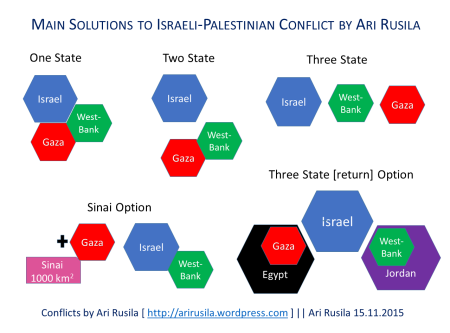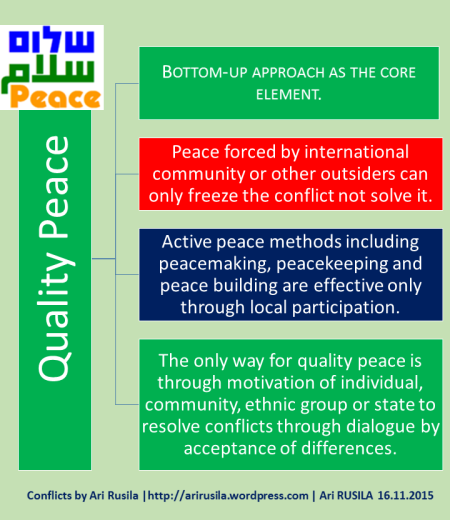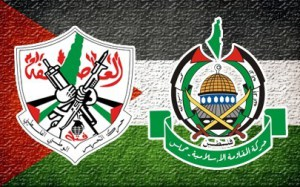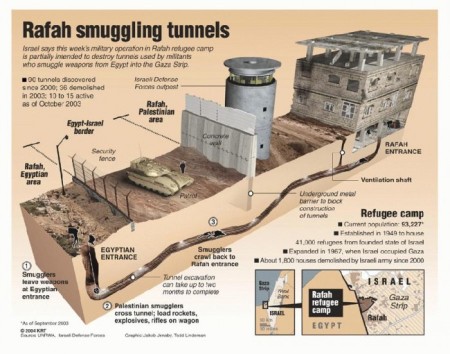Text version in
Gaza’s humanitarian city?
21 hours ago
- a personal perspective on events in western Balkans and MENA. Topics of interest: Balkans, Israel, Serbia, EU enlargement,conflicts, crisis management. My Main Blog - Conflicts By Ari Rusila - with document library and link lists you may find from address http://arirusila.wordpress.com. My Ariel -website covers Israeli politics, defence and society in Finnish language in address - http://arielfi.wordpress.com
 Antisemitism in the Soviet Union reached new heights after 1948 during the campaign against the "rootless cosmopolitan", in which numerous Yiddish-writing poets, writers, painters and sculptors were killed or arrested. This culminated in the so-called “Doctors' trials”, in which a group of doctors (some of whom were Jewish) had allegedly conspired to murder Stalin.
Antisemitism in the Soviet Union reached new heights after 1948 during the campaign against the "rootless cosmopolitan", in which numerous Yiddish-writing poets, writers, painters and sculptors were killed or arrested. This culminated in the so-called “Doctors' trials”, in which a group of doctors (some of whom were Jewish) had allegedly conspired to murder Stalin. One example of the good health of Jewish society in Putin-era Russia is Moscow’s new [est. 2012] Jewish Museum and Tolerance Center – probably the largest Jewish history museum in the world. Mr. Putin has extended his personal support to the lavish project, donating a month’s salary for its construction, which cost around $50 million. The construction of a massive monument to Jewish identity would seem to be a pretty strange thing for an anti-Semite to do.
One example of the good health of Jewish society in Putin-era Russia is Moscow’s new [est. 2012] Jewish Museum and Tolerance Center – probably the largest Jewish history museum in the world. Mr. Putin has extended his personal support to the lavish project, donating a month’s salary for its construction, which cost around $50 million. The construction of a massive monument to Jewish identity would seem to be a pretty strange thing for an anti-Semite to do.“It is in Russia that people are genuinely concerned about the threat of neo-Nazism, Holocaust denial and revisionist approaches to World War II. Many leaders in different countries prefer to keep quiet about it, but here in Russia the matter is openly addressed. Tomorrow we fly to Sevastopol, where we will once again remember the 6 million [Jews] that died… for us, it is very gratifying to see how it is in Russia, a country where the Jewish way of life was previously banned, that such a dynamic Jewish community exists now. We are grateful to the government for its support and for the fight against anti-Semitism.

 The Israeli-Palestinian peace process – or lack of that – is now at the crossroads. To start or not direct negotiations, between Israel and Palestinian Authority or at regional level, with or without preconditions, with or without facilitators, with 2-State
The Israeli-Palestinian peace process – or lack of that – is now at the crossroads. To start or not direct negotiations, between Israel and Palestinian Authority or at regional level, with or without preconditions, with or without facilitators, with 2-State
 One State scenario means “Isralestine”, a binational state to West from Jordan River or federation/confederation. Omer Bar-Lev - an MK for the Zionist Union – claims that Israel’s approach to security lacks creativity and initiative. He hits the nail on the head by concluding the one-state dilemma as follows:
One State scenario means “Isralestine”, a binational state to West from Jordan River or federation/confederation. Omer Bar-Lev - an MK for the Zionist Union – claims that Israel’s approach to security lacks creativity and initiative. He hits the nail on the head by concluding the one-state dilemma as follows:If Israel wants to be a democratic state, which it does, then it has to either grant them full citizenship rights, which will subsequently destroy Zionism (one state for two nations) or separate from the Palestinians (two states for two nations). In that case, Israel can keep the Zionist spirit. Then, it is for the Palestinians to decide to create their Palestinian State, which is in their interests and they will make their own decisions. (Source: Fathom)Indeed one-state option in my opinion would destroy Israel as ‘Jewish homeland’ as both democracy and ‘Jewish Israel’ could not survive in this solution. Failure of negotiations or lack of unilateral actions is shaping Israel and West-Bank more and more towards de facto ‘1-State’.
 With “official” 2-State Solution there is other 2-State options such as Gaza and Palestine option (more e.g. in Gaza State Under Construction, West Bank Remains Bystander ). With this version Israel and Hamas could negotiate a deal which could lead to Gaza State while the future of Palestine state in West-Bank would stay unclear. This (part) solution could be stronger by combining it to recently again proposed Sinai option.
With “official” 2-State Solution there is other 2-State options such as Gaza and Palestine option (more e.g. in Gaza State Under Construction, West Bank Remains Bystander ). With this version Israel and Hamas could negotiate a deal which could lead to Gaza State while the future of Palestine state in West-Bank would stay unclear. This (part) solution could be stronger by combining it to recently again proposed Sinai option. For 19 years, Judea and Samaria were part of Jordan, its population Jordanian citizens, and the geographic juxtaposition between Israel and Jordan should make delineating the border between the two countries in an agreement considerably easier than reaching a deal on a border between Israel and a Palestinian state that might be established in the area. If three state solution will be implemented so Israel would receive security guarantees from Jordan's monarchy, which made peace with Israel in 1994, rather than from a politically enfeebled Palestinian president as well from Egypt, which has peace deal with Israel since 1978, rather than from outside supervised Hamas.
For 19 years, Judea and Samaria were part of Jordan, its population Jordanian citizens, and the geographic juxtaposition between Israel and Jordan should make delineating the border between the two countries in an agreement considerably easier than reaching a deal on a border between Israel and a Palestinian state that might be established in the area. If three state solution will be implemented so Israel would receive security guarantees from Jordan's monarchy, which made peace with Israel in 1994, rather than from a politically enfeebled Palestinian president as well from Egypt, which has peace deal with Israel since 1978, rather than from outside supervised Hamas.


 Post reports that Palestinian Authority President Mahmoud Abbas was quoted on Monday [9th November 2015] as claiming that Israel and Hamas have been conducting direct negotiations to expand the Gaza Strip so that it would include some 1,000 square kilometers of Sinai. Abbas, who was recently visiting in Cairo, told that the idea of slicing off land from Sinai to expand the Gaza Strip was first proposed by ousted Egyptian President Mohamed Morsi.
Post reports that Palestinian Authority President Mahmoud Abbas was quoted on Monday [9th November 2015] as claiming that Israel and Hamas have been conducting direct negotiations to expand the Gaza Strip so that it would include some 1,000 square kilometers of Sinai. Abbas, who was recently visiting in Cairo, told that the idea of slicing off land from Sinai to expand the Gaza Strip was first proposed by ousted Egyptian President Mohamed Morsi. A similar idea was floated some eight years ago by Israeli academics, but it was rejected outright by the regime of then-Egyptian President Hosni Mubarak. Experts surmise that Sisi's generous offer stems from Egypt's current difficulty in controlling terrorist groups based in the Sinai Peninsula. Source: Israel Hayom
A similar idea was floated some eight years ago by Israeli academics, but it was rejected outright by the regime of then-Egyptian President Hosni Mubarak. Experts surmise that Sisi's generous offer stems from Egypt's current difficulty in controlling terrorist groups based in the Sinai Peninsula. Source: Israel Hayom
 Glenn Greenwald, known especially from Snowden case, is a founding editor of The Intercept, which published following anti-drone report based on leaked documents. The Intercept has set up a secure drop box to facilitate government employees’ illegally providing classified information to the organization. These persons are refered as “whistleblowers.” Sure leakers have different motives and have made preselection what material to leak and as a result investigative journalists have only one part of the total material for use for their analysis. Despite these shortcomings the leaked documents and follow-up analysis give anyway an inside view about issue.
Glenn Greenwald, known especially from Snowden case, is a founding editor of The Intercept, which published following anti-drone report based on leaked documents. The Intercept has set up a secure drop box to facilitate government employees’ illegally providing classified information to the organization. These persons are refered as “whistleblowers.” Sure leakers have different motives and have made preselection what material to leak and as a result investigative journalists have only one part of the total material for use for their analysis. Despite these shortcomings the leaked documents and follow-up analysis give anyway an inside view about issue. Based on leaked documents TRANSCEND Media Service has now published a special feature to give even more deeper view about issue with following articles:
Based on leaked documents TRANSCEND Media Service has now published a special feature to give even more deeper view about issue with following articles: Hitler hosts the Mufti on Nov. 1941 in Berlin
Hitler hosts the Mufti on Nov. 1941 in BerlinThe Arabs were Germany’s natural friends because they had the same enemies as had Germany, namely the English, the Jews and the Communists. The Fuhrer replied that Germany’s fundamental attitude on these questions, as the Mufti himself had already stated, was clear. Germany stood for uncompromising war against the Jews. That naturally included active opposition to the Jewish national home in Palestine, which was nothing other than a center, in the form of a state, for the exercise of destructive influence by Jewish interests. Germany was resolved, step by step, to ask one European nation after the other to solve its Jewish problem, and at the proper time to direct a similar appeal to non-European nations as well.Anyway in the entire text there is not a single reference to 'Jew burning' as Israeli PM Benjamin Netanyahu suggested in his speech on 20th Oct. 2015.

In the fateful months of September/October 1941, the goal of Nazi Jewish policy fundamentally changed from a vision of expulsion and decimation to one of total and systematic extermination. Many decisions were still to be taken concerning how, when, at what rate, in what sequence, and with what temporary exemptions. But the “basic decisions” and “total clarity” sought by Höppner [Rolf-Heinz Höppner, the chief ethnic-cleanser in the Warthegau, expressed his frustration in his memorandum] in early September were now there. Those working on the Jewish question were no longer in doubt about what “working toward the Führer” meant and what was expected of them. This new vision of total eradication—to be carried out in “reception camps in the east” through “special measures” such as Brack’s “gassing apparatuses” and encompassing even the Jewish women and children of Belgrade and the Spanish Jews in France—differed fundamentally from the old vision. Among the many decisions taken in the course of the evolution of Nazi Jewish policy, in my opinion, this was the single most important one. The watershed between previous policies and the Final Solution had been crossed.
 During WWII there was for murderous foreign antisemites, such as the dictatorial Croat Ante Pavelic, The Pope or the Romanian Ion Antonescu, as well as the Mufti, in Europe, however no serious historian would claim any of them influenced his decision to murder Europe’s Jews as these men were remote from the decision-making inner circles of the Third Reich. Nazi murderousness towards the Jews burst onto German and Austrian streets during Kristallnacht in November 1938, while its keener SS Jew-killers got ahead of themselves from day one of the September 1939 invasion of Poland. Well before Mufti-Hitler meeting November 1941 and Wannasee December 1941 there had been Hitler’s “prophetic” speech on January 30 of that year when he said that the outbreak of a world war would result “in the annihilation of the Jewish race in Europe”.
During WWII there was for murderous foreign antisemites, such as the dictatorial Croat Ante Pavelic, The Pope or the Romanian Ion Antonescu, as well as the Mufti, in Europe, however no serious historian would claim any of them influenced his decision to murder Europe’s Jews as these men were remote from the decision-making inner circles of the Third Reich. Nazi murderousness towards the Jews burst onto German and Austrian streets during Kristallnacht in November 1938, while its keener SS Jew-killers got ahead of themselves from day one of the September 1939 invasion of Poland. Well before Mufti-Hitler meeting November 1941 and Wannasee December 1941 there had been Hitler’s “prophetic” speech on January 30 of that year when he said that the outbreak of a world war would result “in the annihilation of the Jewish race in Europe”.
After the meeting... Hitler made a fifth decision that would end millions of lives. He ordered [SS second-in-command Reinhard] Heydrich to organize a conference within ten days to prepare the "final solution to the Jewish question." Thus, Hitler made his key decision to start the genocide with al-Husseini's anti-Jewish rhetoric and insistence on wiping out the Jews fresh in his ears.The evidence for this theory is however almost non-existing. Even if the mufti wanted the Final Solution to be expanded, he wasn't the one who came up with the idea.

His opposition to the British peaked during the 1936–39 Arab revolt in Palestine. In 1937, evading an arrest warrant, he fled Palestine and took refuge in, successively, the French Mandate of Lebanon and the Kingdom of Iraq, until he established himself in Fascist Italy and Nazi Germany. During World War II he collaborated with both Italy and Germany by making propagandistic radio broadcasts and by helping the Nazis recruit Bosnian Muslims for the Waffen-SS. On meeting Adolf Hitler he requested backing for Arab independence and support in opposing the establishment in Palestine of a Jewish national home. At war's end, he came under French protection, and then sought refuge in Cairo to avoid prosecution. In 1933, within weeks of Hitler's rise to power in Germany, the German Consul-General in Palestine, Heinrich Wolff, sent a telegram to Berlin reporting al-Husseini's belief that Palestinian Muslims were enthusiastic about the new regime and looked forward to the spread of Fascism throughout the region.
The Mufti was one of the initiators of the systematic extermination of European Jewry for the Germans and had been the permanent collaborator and advisor of Eichmann and Himmler in the execution of the plan…According to my opinion, the Grand Mufti, who had been in Berlin since 1941, played a role in the decision of the German government to exterminate the European Jews, the importance of which must not be disregarded, He had repeatedly suggested to the various authorities with who had been in contact, above all before Hitler, Ribbentrop and Himmler, the extermination of European Jewry. He considered this as a comfortable solution of the Palestinian problem. In his messages broadcast from Berlin, he surpassed us in anti-Jewish attacks. He was one of Eichmann’s best friends and had constantly incited him to accelerate the extermination measures…
“No one denies the Mufti’s Arabic language radio broadcasts, his recruitment of the Islamic SS unit, and his active involvement in SS round ups of Jews in Yugosolvia. And there is no doubt that Mufti was aware of the Final Solution, fully supported it, and sought to extend it to the Arab world. In 1961, when Eichmann was brought to justice in Jerusalem, Israel’s then foreign minister, Golda Meir, called for the Mossad to apprehend the Mufti and to sit him alongside Eichmann on trial in Jerusalem.”
 Related to Jerusalem Grand Mufti Haj Amin al-Husseini's role in the extermination of European Jewry, veteran journalist Haviv Kanaan has reviewed the senior Muslim clergyman's actions in 1942, when the Jewish community in then-British Mandate Palestine was preparing for the possibility of a Nazi invasion. Kanaan said that in 1968 he met with Faiz Bay Idrisi, a senior Arab officer in the Mandate Police, who spoke of al-Husseini's intention to build a crematorium in the northwest Samarian hills. Idrisi told Kanaan at the time, recalling how in case of a German invasion "Haj Amin Husseini was gearing to enter Jerusalem at the head of the Muslim Arab Legion squadron he'd created for the Third Reich. The mufti's plan was to build a huge Auschwitz-like crematorium in the Dotan Valley, near Nablus, to which Jews from Palestine, Iraq, Egypt, Yemen, Syria, Lebanon, and North Africa would be imprisoned and exterminated, just like the Jews in the death camps in Europe." (Source: Israel Hayom )
Related to Jerusalem Grand Mufti Haj Amin al-Husseini's role in the extermination of European Jewry, veteran journalist Haviv Kanaan has reviewed the senior Muslim clergyman's actions in 1942, when the Jewish community in then-British Mandate Palestine was preparing for the possibility of a Nazi invasion. Kanaan said that in 1968 he met with Faiz Bay Idrisi, a senior Arab officer in the Mandate Police, who spoke of al-Husseini's intention to build a crematorium in the northwest Samarian hills. Idrisi told Kanaan at the time, recalling how in case of a German invasion "Haj Amin Husseini was gearing to enter Jerusalem at the head of the Muslim Arab Legion squadron he'd created for the Third Reich. The mufti's plan was to build a huge Auschwitz-like crematorium in the Dotan Valley, near Nablus, to which Jews from Palestine, Iraq, Egypt, Yemen, Syria, Lebanon, and North Africa would be imprisoned and exterminated, just like the Jews in the death camps in Europe." (Source: Israel Hayom )
 Despite restrictions there has been whole time – even during conflicts/wars - movement of commodities as well Palestinians to and from Gaza via Israeli border crossings. During last months movement of goods has increased via Kerem Shalom Crossing at Israeli border to/from Gaza but is almost non-existent via Rafah Crossing at Egyptian border. Besides official border crossings Egypt is now implementing measures which will totally block unofficial traffic aka smuggling. In my opinion Egypt not Israel is blocking Gaza.
Despite restrictions there has been whole time – even during conflicts/wars - movement of commodities as well Palestinians to and from Gaza via Israeli border crossings. During last months movement of goods has increased via Kerem Shalom Crossing at Israeli border to/from Gaza but is almost non-existent via Rafah Crossing at Egyptian border. Besides official border crossings Egypt is now implementing measures which will totally block unofficial traffic aka smuggling. In my opinion Egypt not Israel is blocking Gaza.

 Palestinians inspect the damage after Egyptian forces flooded smuggling tunnels dug beneath the Gaza-Egypt border, in Rafah in the southern Gaza Strip September 18, 2015. | Photo: REUTERS/Ibraheem Abu Mustafa
Palestinians inspect the damage after Egyptian forces flooded smuggling tunnels dug beneath the Gaza-Egypt border, in Rafah in the southern Gaza Strip September 18, 2015. | Photo: REUTERS/Ibraheem Abu Mustafa Gaza Import/Export, August 2015
Gaza Import/Export, August 2015
